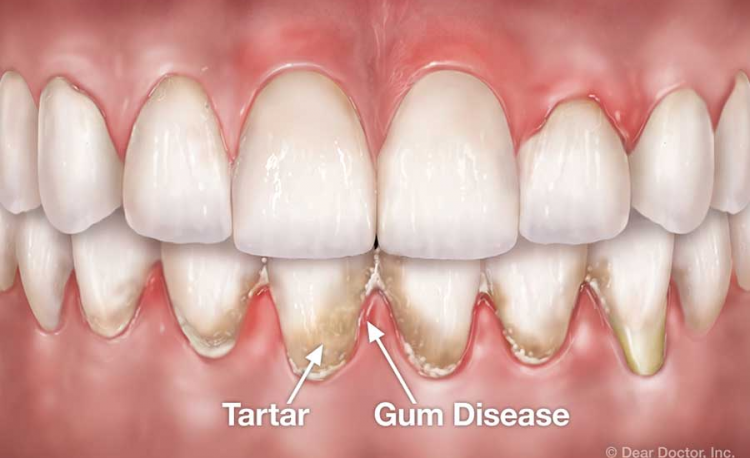Periodontitis It is a progressive inflammatory disease of the gums and the surrounding tissue around the teeth. It is commonly known as gum disease and was referred to as pyorrhea in the old days. It is estimated that up to 80% of the population above the age of 40 may suffer from this disease with the severity varying drastically from one person to another.
Periodontitis is the number one cause of tooth loss after the age of 40.
Periodontal disease is an infection of the tissues that support your teeth. Your gum tissue is not attached to the teeth as high as it may seem. There is a very shallow v-shaped crevice called a sulcus between the tooth and gums. Periodontal diseases attack just below the gum line in the sulcus, where they cause the attachment of the tooth and its supporting tissues to break down. As the tissues are damaged, the sulcus develops into a pocket: generally, the more severe the disease, the greater the depth of the pocket.
Periodontal diseases are classified according to the severity of the disease. The two major stages are gingivitis and periodontitis. Gingivitis is a milder and reversible form of periodontal disease that only affects the gums. Gingivitis may lead to more serious, destructive forms of periodontal disease called periodontitis.
Certain medical conditions or medications can make you more susceptible to gum disease. They include pregnancy, diabetes, epilepsy, and such medications as chemotherapy, birth control pills, antidepressants, and those for heart problems.
If you notice any of the following signs of gum disease, schedule an appointment immediately:
- gums that bleed when you brush your teeth
- red, swollen or tender gums
- gums that have pulled away from the teeth
- bad breath that doesn’t go away
- pus between your teeth and gums
- loose teeth
- a change in the way your teeth fit together when you bite
- a change in the fit of partial dentures
Non-Surgical Therapy
Scaling and Polishing: Manually removing the plaque and tarter from the root surfaces of your teeth below the gum line.
Antibiotics: Because bacteria cause periodontitis antibiotics may be prescribed. Antibacterial mouth rinses may also be recommended to help plaque control.
Bite correction: An imbalanced bite may accelerate bone destruction. Your teeth may be adjusted for proper and better function. A Bite-guard (removable retainer fitting over teeth) may be required to protect teeth surfaces and relax tense muscles.
Splinting: This technique attaches weak teeth together, combining them into a stronger single unit, making them more stable and offering more comfortable chewing.
Surgical Therapy
Flap Surgery: Our periodontist separates the gum from the teeth creating a “flap” and accesses the infected pocket. It aims to reduce pocket depth and increase the ability to maintain the remnant pockets clean.
Gingivectomy: This procedure is performed when excess amounts of gum growth around the teeth have occurred. These results in false pocket formation and the inability to keep them clean.
Osseous (bone) surgery: This procedure is done in combination with a surgical flap operation where gum growth into a defect is stopped to allow slower growing bone, cementum and ligament cells to grow.
Bone Grafts: Tiny fragments of the patient’s bone, synthetic bone or bone obtained from a bone bank are used to fill a bony defect around the teeth. These grafts act as a scaffold on or around which patients own bone is conducted or induced to grow.
Soft Tissue Graft: In cases of gum recession a graft is usually taken from the palate and transplanted onto the receding area to reinforce the thin gum and to inhibit further gum recession.

